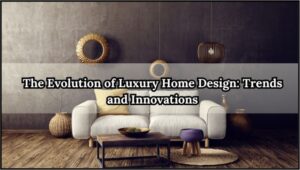
Image Source: Canva
Modern luxury homes have significantly evolved. They now reflect new tech, changing lifestyles, and a bigger focus on being eco-friendly. It’s no longer just about opulence and comfort—it’s about smart living, environmental consciousness, and personal expression. This article explores the latest trends in luxury home design, providing insights into what makes a home truly luxurious today and how to incorporate these elements into your space.
The Rise of Sustainable Luxury
One of the most prominent trends in luxury home design is integrating eco-friendly materials. High-end homeowners are increasingly prioritizing sustainability, opting for materials that are both luxurious and environmentally responsible. Recycled metals, reclaimed wood, and natural stone are popular choices, blending aesthetic appeal with ecological mindfulness.
Luxury homes are now designed with energy efficiency in mind. Advanced insulation, energy-efficient windows, and sustainable roofing materials help reduce energy consumption. Voice-activated assistants, such as Amazon’s Alexa and Google Home, have become staples in luxury homes.
| Material | Description | Benefits |
| Recycled Metals | Metals that have been repurposed | Reduces waste and mining impact |
| Reclaimed Wood | Wood salvaged from old structures | Preserves natural resources, a unique look |
| Natural Stone | Stone extracted with minimal impact | Durable, low maintenance, timeless appeal |
| Bamboo | Fast-growing renewable resource | Strong, lightweight, eco-friendly |
| Low-VOC Paints | Paints with low-volatile organic compounds | Improves indoor air quality, safer for health |
This trend is particularly noticeable in places like Driggs Idaho, where the natural surroundings inspire homeowners to embrace sustainable living. Those looking for homes for sale in Driggs Idaho will find many properties that display these eco-friendly and energy-efficient innovations.
Smart Home Technology
The integration of smart home technology is revolutionizing luxury home design. Home automation systems allow homeowners to control lighting, climate, security, and entertainment systems from a central hub or even remotely via smartphones. This level of control enhances convenience, security, and energy efficiency.
Voice-activated assistants like Amazon’s Alexa and Google Home have become staples in luxury homes. These devices offer hands-free control over various aspects of the home, from adjusting thermostats to playing music, providing an unparalleled level of comfort and convenience.
Open Floor Plans and Multifunctional Spaces
Modern luxury home design often features open floor plans that create a seamless flow between indoor and outdoor spaces. Large sliding glass doors, retractable walls, and expansive patios blur the lines between the interior and exterior, creating a harmonious living environment that takes full advantage of natural light and scenic views.
The trend toward multifunctional spaces is also prevalent in luxury home design. Homeowners are seeking versatile living areas that can adapt to various needs, such as home offices, gyms, and entertainment rooms. This flexibility is particularly valuable in the wake of the COVID-19 pandemic, as more people work and entertain at home.
Personalized Design and Customization
Personalization is a fundamental aspect of modern luxury home design. Homeowners are investing in bespoke interiors that reflect their tastes and lifestyles. Custom cabinetry, unique lighting fixtures, and tailor-made furniture pieces are just a few examples of how luxury homes are personalized to create a distinctive living experience.
Incorporating art and collectibles into home design is another way luxury homeowners are personalizing their spaces. Curated collections of artwork, sculptures, and rare objects add character and sophistication, making each home a unique reflection of its owner’s personality and passions.
Wellness and Advanced Security Systems

Image Source: Canva
Home Spas and Wellness Centers
A focus on wellness has become integral to luxury home design. Homeowners are incorporating spa-like features into their homes, such as saunas, steam rooms, and massage rooms. Wellness centers equipped with yoga studios, meditation rooms, and state-of-the-art gyms are also becoming increasingly popular.
Air and Water Quality
Ensuring high air and water quality is a top priority in luxury homes. Advanced filtration systems that provide purified air and water are essential features, that promote a healthy living environment. Additionally, the use of non-toxic building materials and finishes helps create a healthier indoor atmosphere.
Comprehensive Surveillance
Security is a paramount concern for luxury homeowners. Advanced security systems with comprehensive surveillance capabilities, including high-definition cameras, motion sensors, and biometric access controls, offer peace of mind. These systems are often integrated with smart home technology, ensuring seamless monitoring and control.
Safe Rooms and Panic Rooms
Safe rooms and panic rooms are increasingly being incorporated into luxury homes. These fortified spaces provide a secure refuge in the event of an emergency, equipped with reinforced walls, independent communication systems, and emergency supplies.
Innovative Architectural Kitchen and Bath Design
Minimalist and Modern Aesthetics
Modern luxury home design often embraces minimalist aesthetics. Clean lines, open spaces, and a focus on functionality characterize this design approach. High-quality materials and sophisticated finishes create a sense of understated elegance, emphasizing quality over quantity.
Organic and Biophilic Design
Biophilic design, which emphasizes the connection between humans and nature, is gaining traction in luxury home design. This approach incorporates natural elements, such as green walls, indoor gardens, and natural light, to create a calming and restorative environment. Organic architectural forms that mimic natural shapes and patterns are also becoming more common.
Gourmet Kitchens
The kitchen is often considered the heart of the home, and this is especially true in luxury residences. Gourmet kitchens equipped with professional-grade appliances, custom cabinetry, and high-end finishes are a staple. Features like large kitchen islands, wine cellars, and walk-in pantries add to the functionality and luxury of the space.
Spa-Like Bathrooms
Luxury bathrooms are designed to offer a spa-like experience. Features such as rain showers, freestanding tubs, heated floors, and integrated sound systems transform the bathroom into a sanctuary. High-quality materials like marble, granite, and onyx add a touch of opulence.
Technological Innovations in Home Entertainment
Home theaters have become a standard feature in luxury homes. These spaces are designed to replicate the cinematic experience, with high-definition projectors, surround sound systems, and plush seating. Acoustic treatments and soundproofing ensure an immersive viewing experience.
With the rise of virtual reality and advanced gaming technology, dedicated gaming and VR rooms are becoming increasingly popular in luxury homes. These spaces are equipped with the latest gaming consoles, VR equipment, and comfortable seating to provide an unparalleled gaming experience.
Outdoor Living and Landscaping
Outdoor living spaces have become extensions of the home, offering areas for relaxation, entertainment, and recreation. Features such as outdoor kitchens, fire pits, and infinity pools create a resort-like atmosphere. High-quality outdoor furniture and landscape lighting enhance the overall aesthetic.
Sustainable landscaping practices are being incorporated into luxury home design. Native plants, xeriscaping, and rainwater harvesting systems reduce environmental impact while maintaining beautiful and functional outdoor spaces. Green roofs and living walls further integrate sustainability into the landscape design.
The Future of Luxury Home Design
The future of luxury home design is poised to be shaped by advancements in AI and robotics. Luxury homes will become even more convenient and functional with automated cleaning systems and AI-powered home assistants. Robotics may also improve construction, allowing for more precise designs.
Sustainability will play a bigger role in luxury home design due to growing environmental concerns. Future homes will prioritize both comfort and the planet’s health. Technological advances will enable more customization, allowing homeowners to create spaces tailored to their needs and preferences. This will lead to more unique and luxurious living environments.
Conclusion
The evolution of luxury home design is a testament to the dynamic nature of architecture and interior design. As trends and technologies continue to evolve, luxury homes are becoming more sustainable, technologically advanced, and personalized than ever before.
Whether through the use of eco-friendly materials, smart home systems, or bespoke interiors, the future of luxury home design promises to offer unparalleled levels of comfort, convenience, and sophistication.
Frequently Asked Questions
1. What materials are considered eco-friendly in luxury home design?
Eco-friendly materials commonly used in luxury home design include recycled metals, reclaimed wood, natural stone, bamboo, and low-VOC paints and finishes.
2. How do smart home technologies enhance luxury living?
Smart home technologies enhance luxury living by providing automated control over lighting, climate, security, and entertainment systems, increasing convenience, security, and energy efficiency.
3. What are some examples of wellness features in luxury homes?
Examples of wellness features include home spas with saunas and steam rooms, advanced air and water filtration systems, yoga studios, meditation rooms, and state-of-the-art gyms.
4. What is biophilic design, and why is it important?
Biophilic design is an approach that emphasizes the connection between humans and nature, incorporating natural elements like green walls and indoor gardens to create a calming and restorative environment. It is important because it enhances mental and physical well-being.






